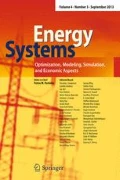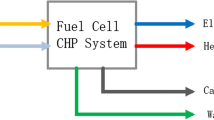Abstract
Fuel cell-based micro-cogeneration systems are seen to be one of promising technologies for distributed power generation for households. In this work, the operational performance of a 1 kW\(_{\mathrm{e}}\) residential micro-cogeneration system based on a high temperature proton exchange membrane fuel cell (HT-PEMFC) is investigated. A design concept of a system consisting of a fuel processing unit and power generating unit is implemented using mathematical models in gPROMS Model Builder\(^{\circledR }\). The objective outputs evaluated includes the energy outputs and their corresponding efficiencies (thermal and electrical) and the cogeneration efficiency. The fuel ratio, fuel flow rate, current density and fuel utilization were varied in order to examine their effect on the overall performance of the cogeneration system. Depending on the operating point chosen, the analyses of the system show that electrical efficiencies of 42.8%, thermal efficiency of 47.2% and cogeneration efficiencies of 90% can be achieved.













Similar content being viewed by others
Abbreviations
- a :
-
Catalyst surface area, m\(^{2 }\) g\(^{-1}\)
- c :
-
Concentration, mol m\(^{-3}\)
- \(C^{{ Pt}}\) :
-
Concentration on the catalyst surface, mol m\(^{-3}\)
- \(C_{{ dissolved}}\) :
-
Equilibrium concentration, mol m\(^{-3}\)
- \(C^{{ ref}}\) :
-
Reference concentration on the catalyst surface, mol m\(^{-3}\)
- \(D_{{ ij}}^{{ eff}}\) :
-
Binary diffusion coefficient, m\(^{2}\) s\(^{-1}\)
- \(D^{H_3 PO_4 }\) :
-
Diffusion coefficient of hydrogen/oxygen in phosphoric acid, cm\(^{2}\) s\(^{-1}\)
- Ea :
-
Activation energy, kJ mol\(^{-1}\)
- F :
-
Faraday constant, 96,485 C mol\(^{-1}\)
- y :
-
Mole fraction
- \(i_o\) :
-
Exchange current density, A m\(^{-2}\)
- \(i_o^{{ ref}}\) :
-
Reference exchange current density, A m\(^{-2}\)
- j :
-
Exchange current density, A m\(^{-2}\)
- \({ LHV}\) :
-
Lower heating value J kg\(^{-1}\)
- M :
-
Molecular mass, g mol\(^{-1}\)
- \(\dot{m}\) :
-
Mass flow rate, kg s\(^{-1}\)
- N :
-
Molar flux, mol s\(^{-1}\) m\(^{-2}\)
- n :
-
No of electrons transferred
- p :
-
Pressure, bar
- \(P_{{ elec}}\) :
-
Electrical power, W
- R :
-
Gas constant, 8.314 J mol\(^{-1}\)K\(^{-1}\)
- r :
-
reaction rate, kmol s\(^{-1}\) kg\(_{{ cat}}^{-1}\)
- \(Q_{{ th}}\) :
-
Thermal power, W
- \(S_{{ Pt}}\) :
-
Real platinum surface area, m\(^{2}\)
- T :
-
Temperature, K
- \(T_{{ ref}}\) :
-
Reference temperature, K
- u :
-
Velocity, m s\(^{-1}\)
- \(V_{{ cell}}\) :
-
Cell voltage, V
- \(V_{{ ocv}}\) :
-
Open circuit voltage, V
- W :
-
Acid doping level
- X :
-
Distribution domain
- \(\gamma \) :
-
Reaction order
- \(\alpha \) :
-
Transfer coefficient
- \(\varepsilon \) :
-
Porosity
- \(\theta _{{ CO}}\) :
-
Catalyst site coverance by carbon monoxide
- \(\eta _{{ act}}\) :
-
Activation loss, V
- \(\eta _{{ ohm}}\) :
-
Ohmic loss, V
- \(\eta _{{ elec}}\) :
-
Electrical efficiency, %
- \(\eta _{{ th}}\) :
-
Thermal efficiency, %
- \(\eta _{{ cogen}}\) :
-
Cogeneration efficiency, %
- \(\kappa \) :
-
Proton conductivity, S cm\(^{-1}\)
References
Swan, L.G., Ugursal, V.I.: Modeling of end-use energy consumption in the residential sector: a review of modeling techniques] Renew. Sust. Energy Rev. 13(8), 1819–1835 (2009). doi:10.1016/j.rser.2008.09.033
Donadel, C.B., Fardin, J.F., Encarnação, L.F.: Electrical distribution network operation with a presence of distributed generation units in a Pre Smart Grid environment using a clustering-based methodology. Energy Syst. 6(4), 455–477 (2015). doi:10.1007/s12667-015-0150-z
Vita, V., Ekonomou, L., Christodoulou, C.A.: The impact of distributed generation to the lightning protection of modern distribution lines. Energy Syst 7, 357–364 (2016). doi:10.1007/s12667-015-0175-3
Maghanki, M.M., Ghobadian, B., Najafi, G., Galogah, R.J.: Micro combined heat and power (MCHP) technologies and applications. Renew. Sustain. Energy Rev. 28, 510–524 (2013). doi:10.1016/j.rser.2013.07.053
Andújar, J.M., Segura, F.: Fuel cells: history and updating. A walk along two centuries. Renew. Sustain. Energy Rev. 13(9), 2309–2322 (2009). doi:10.1016/j.rser.2009.03.015
Wang, Y., Chen, K.S., Mishler, J., Cho, S.C., Adroher, X.C.: A review of polymer electrolyte membrane fuel cells: technology, applications, and needs on fundamental research. Appl. Energy 88(4), 981–1007 (2011). doi:10.1016/j.apenergy.2010.09.030
Napoli, R., Gandiglio, M., Lanzini, A., Santarelli, M.: Techno-economic analysis of PEMFC and SOFC micro-CHP fuel cell systems for the residential sector. Energy Build. 103, 131–146 (2015). doi:10.1016/j.enbuild.2015.06.052
Hongbo, R., Weijun, G.: Economic and environmental evaluation of micro CHP systems with different operating modes for residential buildings in Japan. Energy Build. 42, 853–861 (2010)
Wakui, T., Yokoyama, R.: Optimal sizing of residential SOFC cogeneration system for power interchange operation in housing complex from energy-saving viewpoint. Energy 41(1), 65–74 (2012). doi:10.1016/j.energy.2011.06.056
Roshandel, R., Parhizgar, T.: A new approach to optimize the operating conditions of a polymer electrolyte membrane fuel cell based on degradation mechanisms. Energy Syst. 4(3), 219–237 (2013). doi:10.1007/s12667-012-0075-8
Dincer, I., Acar, C.: Review and evaluation of hydrogen production methods for better sustainability. Int. J. Hydrogen Energy 40(34), 11094–11111 (2015). doi:10.1016/j.ijhydene.2014.12.035
Qingfeng, L., Hjuler, H.A., Bjerrum, N.J.: Phosphoric acid doped polybenzimidazole membranes: physiochemical characterization and fuel cell applications. J. Appl. Electrochem. 31(7), 773–779 (2001). doi:10.1023/a:1017558523354
Chandan, A., Hattenberger, M., El-kharouf, A., Du, S., Dhir, A., Self, V., Pollet, B.G., Ingram, A., Bujalski, W.: High temperature (HT) polymer electrolyte membrane fuel cells (PEMFC)—a review. J. Power Sources 231, 264–278 (2013). doi:10.1016/j.jpowsour.2012.11.126
Park, J., Min, K.: Dynamic modeling of a high-temperature proton exchange membrane fuel cell with a fuel processor. Int. J. Hydrogen Energy 39(20), 10683–10696 (2014). doi:10.1016/j.ijhydene.2014.04.210
Sahlin, S.L., Andreasen, S.J., Kær, S.K.: System model development for a methanol reformed 5 kW high temperature PEM fuel cell system. Int. J. Hydrogen Energy 40(38), 13080–13089 (2015). doi:10.1016/j.ijhydene.2015.07.145
Romero-Pascual, E., Soler, J.: Modelling of an HTPEM-based micro-combined heat and power fuel cell system with methanol. Int. J. Hydrogen Energy 39(8), 4053–4059 (2014). doi:10.1016/j.ijhydene.2013.07.015
Samsun, R.C., Pasel, J., Janßen, H., Lehnert, W., Peters, R., Stolten, D.: Design and test of a 5 kWe high-temperature polymer electrolyte fuel cell system operated with diesel and kerosene. Appl. Energy 114, 238–249 (2014). doi:10.1016/j.apenergy.2013.09.054
Moçotéguy, P., Ludwig, B., Scholta, J., Barrera, R., Ginocchio, S.: Long term testing in continuous mode of HT-PEMFC based H3PO4/PBI Celtec-P MEAs for \(\mu \)-CHP applications. Fuel Cells 9(4), 325–348 (2009). doi:10.1002/fuce.200800134
Najafi, B., Haghighat Mamaghani, A., Rinaldi, F., Casalegno, A.: Long-term performance analysis of an HT-PEM fuel cell based micro-CHP system: operational strategies. Appl. Energy 147, 582–592 (2015). doi:10.1016/j.apenergy.2015.03.043
Ersöz, A., Sayar, A.: A process simulation study of a newly designed fuel processing system for a high temperature PEM fuel cell unit. Int. J. Hydrogen Energy 40(42), 14469–14482 (2015). doi:10.1016/j.ijhydene.2015.06.107
Perna, A., Cicconardi, S.P., Cozzolino, R.: Performance evaluation of a fuel processing system based on membrane reactors technology integrated with a PEMFC stack. Int. J. Hydrogen Energy 36(16), 9906–9915 (2011). doi:10.1016/j.ijhydene.2011.05.076
Arsalis, A., Nielsen, M.P., Kær, S.K.: Application of an improved operational strategy on a PBI fuel cell-based residential system for Danish single-family households. Appl. Thermal Eng. 50(1), 704–713 (2013). doi:10.1016/j.applthermaleng.2012.07.025
Najafi, B., Haghighat Mamaghani, A., Rinaldi, F., Casalegno, A.: Fuel partialization and power/heat shifting strategies applied to a 30 kWel high temperature PEM fuel cell based residential micro cogeneration plant. Int. J. Hydrogen Energy 40(41), 14224–14234 (2015). doi:10.1016/j.ijhydene.2015.08.088
Hydrogen and fuel cell program (2011). https://www.hydrogen.energy.gov/pdfs/11014_medium_scale_chp_target.pdf. Accessed 01 April 2016
PSE: gPROMS ModelBuilder v3.6 (2015). http://www.psenterprise.com/. Accessed 15 July 2015
Nomnqa, M., Ikhu-Omoregbe, D., Rabiu, A.: Parametric analysis of a high temperature PEM fuel cell based microcogeneration system. Int. J. Chem. Eng. 2016, 14 (2016). doi:10.1155/2016/4596251
Jiao, K., Alaefour, I.E., Li, X.: Three-dimensional non-isothermal modeling of carbon monoxide poisoning in high temperature proton exchange membrane fuel cells with phosphoric acid doped polybenzimidazole membranes. Fuel 90(2), 568–582 (2011). doi:10.1016/j.fuel.2010.10.018
Scott, K., Mamlouk, M.: A cell voltage equation for an intermediate temperature proton exchange membrane fuel cell. Int. J. Hydrogen Energy 34(22), 9195–9202 (2009). doi:10.1016/j.ijhydene.2009.09.035
Cheddie, D.F., Munroe, N.D.H.: A two-phase model of an intermediate temperature PEM fuel cell. Int. J. Hydrogen Energy 32(7), 832–841 (2007). doi:10.1016/j.ijhydene.2006.10.061
Sousa, T., Mamlouk, M., Scott, K.: An isothermal model of a laboratory intermediate temperature fuel cell using PBI doped phosphoric acid membranes. Chem. Eng. Sci. 65, 2513–2530 (2010). doi:10.1016/j.ces.2009.12.038
Dhar, H.P., Christner, L.G., Kush, A.K., Maru, H.C.: Performance study of a fuel cell Pt-on-C anode in presence of CO and CO\(_{2}\) and calculation of adsorption parameters for CO poisoning. J. Electrochem. Soc. 133(8), 1574–1582 (1986)
Chippar, P., Ju, H.: Three-dimensional non-isothermal modeling of a phosphoric acid-doped polybenzimidazole (PBI) membrane fuel cell. Solid State Ionics 225, 30–39 (2012). doi:10.1016/j.ssi.2012.02.031
Holladay, J.D., Hu, J., King, D.L., Wang, Y.: An overview of hydrogen production technologies. Catal. Today 139(4), 244–260 (2009). doi:10.1016/j.cattod.2008.08.039
Xu, J., Froment, G.F.: Methane steam reforming, methanation and water-gas shift: 1. Intrinsic kinetics. AlChE J. 35(1), 88–96 (1989)
Kim, G.-Y., Mayor, J.R., Ni, J.: Parametric study of microreactor design for water gas shift reactor using an integrated reaction and heat exchange model. Chem. Eng. J. 110(1–3), 1–10 (2005). doi:10.1016/j.cej.2004.05.015
Song, X., Williams, W.R., Schmidt, L.D., Aris, R.: Ignition and extinction of homogeneous-heterogeneous combustion: CH\(_4\) and C\(_3\)H\(_8\) oxidation on PT. Symp. (Int.) Combust. 23(1), 1129–1137 (1991). doi:10.1016/S0082-0784(06)80372-3
Schefer, R.W.: Catalyzed combustion of H\(_2\)/air mixtures in a flat plate boundary layer: II. Numerical model. Combust. Flame 45, 171–190 (1982). doi:10.1016/0010-2180(82)90043-8
Todd, B., Young, J.B.: Thermodynamic and transport properties of gases for use in solid oxide fuel cell modelling. J. Power Sources 110(1), 186–200 (2002). doi:10.1016/S0378-7753(02)00277-X
Bujlo, P., Pasupathi, S., Ulleberg, Ø., Scholta, J., Nomnqa, M.V., Rabiu, A., Pollet, B.G.: Validation of an externally oil-cooled 1 kWel HT-PEMFC stack operating at various experimental conditions. Int. J. Hydrogen Energy 38(23), 9847–9855 (2013). doi:10.1016/j.ijhydene.2013.05.174
Arsalis, A., Nielsen, M.P., Kær, S.K.: Modeling and parametric study of a 1 kWe HT-PEMFC-based residential micro-CHP system. Int. J. Hydrogen Energy 36(8), 5010–5020 (2011). doi:10.1016/j.ijhydene.2011.01.121
Di Bona, D., Jannelli, E., Minutillo, M., Perna, A.: Investigations on the behaviour of 2 kW natural gas fuel processor. Int. J. Hydrogen Energy 36(13), 7763–7770 (2011). doi:10.1016/j.ijhydene.2011.01.110
Zuliani, N., Taccani, R.: Microcogeneration system based on HTPEM fuel cell fueled with natural gas: performance analysis. Appl. Energy 97, 802–808 (2012). doi:10.1016/j.apenergy.2011.12.089
Kazempoor, P., Dorer, V., Ommi, F.: Evaluation of hydrogen and methane-fuelled solid oxide fuel cell systems for residential applications: System design alternative and parameter study. Int. J. Hydrogen Energy 34(20), 8630–8644 (2009). doi:10.1016/j.ijhydene.2009.07.119
Barbir, F.: PEM fuel cells: theory and practise. Academic Press/Elsevier Academic Press, California (2005)
Doherty, W., Reynolds, A., Kennedy, D.: Computer simulation of a biomass gasification-solid oxide fuel cell power system using Aspen Plus. Energy 35(12), 4545–4555 (2010). doi:10.1016/j.energy.2010.04.051
Najafi, B., Haghighat Mamaghani, A., Baricci, A., Rinaldi, F., Casalegno, A.: Mathematical modelling and parametric study on a 30 kWel high temperature PEM fuel cell based residential micro cogeneration plant. Int. J. Hydrogen Energy 40(3), 1569–1583 (2015). doi:10.1016/j.ijhydene.2014.11.093
Acknowledgements
The financial assistance of the National Research Foundation (NRF) of South Africa towards this research is hereby acknowledged. Opinions expressed and conclusions arrived at, are those of the authors and are not necessarily to be attributed to the NRF. The Authors would like to thank Dr. Yusuf Isa from the Durban University of Technology for his assistance with the development of the models.
Author information
Authors and Affiliations
Corresponding author
Rights and permissions
About this article
Cite this article
Nomnqa, M., Ikhu-Omoregbe, D. & Rabiu, A. Performance evaluation of a HT-PEM fuel cell micro-cogeneration system for domestic application. Energy Syst 10, 185–210 (2019). https://doi.org/10.1007/s12667-017-0238-8
Received:
Accepted:
Published:
Issue Date:
DOI: https://doi.org/10.1007/s12667-017-0238-8




